
Car transmissions have a lot of influence on your driving experience – the way each of them works determines the smoothness of your ride, and a whole lot more.
We are used to talking about manual and automatic transmissions, yet the latter comes in several different types. One of them is called continuously variable transmission or CVT.
What is a CVT gearbox, how does it work, and should you consider buying a car that comes with one? Let’s take a deep dive into the inner workings of continuously variable transmissions and find the answers.

Used cars have dark secrets
Reveal them all! Just enter a VIN code and click the button:
What is a CVT gearbox?
A continuously variable transmission is a type of automatic transmission that uses a system of belts, pulleys, or chains to transmit power from a vehicle’s engine to the rest of the drivetrain.
Unlike traditional automatic transmissions, a CVT doesn’t have a fixed set of gears in the conventional sense. Instead, it provides an infinite variation of gear ratios within a specific range, allowing the engine to operate in its most efficient RPM range for the car’s speed and road conditions.
How does a CVT work?
The most common CVT is pulley-based. It consists of a metal belt or chain that runs between two variable-diameter pulleys. Each pulley has two cone-shaped halves that can move in or out. One of them is connected to the engine’s crankshaft, while the other is connected to the wheels.

Put simply, a pulley-based CVT works on the principle of varying the effective diameter of two pulleys.
As you drive, your vehicle’s control system monitors various parameters, such as engine speed, vehicle speed, or load. Based on this data, the system adjusts the positions of the pulley halves by moving the two sheaves of one pulley closer together and the two sheaves of another pulley farther apart.
This alters the effective diameter of the pulleys and, in turn, adjusts the gear ratio. By doing this, the CVT ensures the maximum efficiency of the engine.
What does driving a CVT feel like?
Fundamentally, different operating principles are not the only difference between continuously variable and conventional transmissions. In fact, the absence of fixed gears in CVT (while conventional transmissions usually have four, five, or more) leads to a couple of other differences between them.
For example, automatic and manual transmissions, which require the driver to engage and disengage the transmission manually, sometimes have noticeable shifts between gears. Driving a car with a CVT, you will typically feel no noticeable shifts or jerks during acceleration, as it provides smoother transitions between gear ratios.
Therefore, some drivers describe driving a car with CVT as bland. The engagement and connection with the vehicle are minimal, as you don’t feel or even hear it moving through the shift points, and the engine sound is monotonous. However, if you don’t really mind “not connecting” with your car, you’ll likely enjoy the experience that CVT provides.
What are the advantages of CVT?
CVTs are becoming more popular, and this fact makes more and more drivers consider them as an option when buying a car.
So, what benefits do cars with CVT gearboxes bring?

Increased fuel efficiency
Vehicles with continuously variable transmissions are often more fuel-efficient than their conventional counterparts, especially during stop-and-go traffic and constant-speed cruising. This is because CVTs can optimize engine speed for different driving conditions more precisely, allowing the engine to operate in its most efficient range.
Better driving experience
Since CVTs don’t have noticeable gear shifts, they can provide a more comfortable and relaxed driving experience. It’s especially convenient in urban traffic where frequent acceleration and deceleration occur.
This type of automatic transmission is also very well-suited for different driving styles, which can add up to a better overall experience. Whether you’re a more aggressive driver or just cruising at a constant speed, CVT can adjust to provide the best performance for your situation.
Compact design
CVTs’ light and compact design is one of their notable advantages, contributing to various other benefits.
CVTs generally weigh less and are more compact than automatic and manual transmissions. This reduces overall vehicle weight, meaning that it will need less energy to move than a heavier one. Therefore, a CVT can further improve fuel economy.
Moreover, CVTs can be paired with a wide range of engine sizes and types, allowing manufacturers to use smaller engines without sacrificing performance. For example, CVTs are well-suited for hybrid vehicles, as they can be integrated into the powertrain more seamlessly.
Disadvantages of CVT transmissions in cars
Just like everything else, CVTs also come with some disadvantages that distinguish them from other transmissions.
Here are some things you should be aware of before buying a car with a CVT gearbox.

Durability issues
Although CVTs are quickly improving, in some cases, they’re still considered less durable and reliable than conventional automatic transmissions. For instance, earlier models generally last around 100,000 miles (or about 160,000 kilometers) before needing to be rebuilt.
However, a caring owner can help a CVT last much longer. To do so, frequent oil changes (at least every 50,000 miles or even less) are key, as are proper driving techniques, and regular inspections.
Potential cost of repair
CVTs are often more expensive to repair or replace when compared to conventional automatic transmissions. Although their initial cost is usually lower, the parts of CVTs tend to have higher prices.
Moreover, fixing a CVT requires specialized knowledge and tools, as it’s still a relatively new and evolving technology compared to traditional transmissions. This also adds to the final cost of repairs.
In some cases, if a CVT experiences a major failure, it may be more cost-effective to replace the entire transmission rather than repair individual components – but that can also significantly increase the repair bill.
Noise
When it comes to adjusting gear ratios, CVTs are generally known for providing a quieter driving experience and smoother rides. However, during acceleration or at high speeds, CVTs can make more noise than many drivers are used to, which is one of the most common complaints among their users.
This is due to how CVTs operate, as the engine’s RPM can remain relatively constant during acceleration. Typically, this high-pitched whine is described as “droning.”
Which cars have CVTs?

You’ll be able to find CVTs in vehicles manufactured by some of the biggest industry players, such as Toyota, Nissan, Honda, Subaru, Audi, and many more. There’s no universal reason why makers choose to incorporate continuously variable transmissions in their cars, but the upward trend is already visible, and the popularity of CVTs will continue to grow as they evolve.
Here are some of the popular models that may come with a CVT transmission (note that for cars with multiple engine options, not all may be equipped with a CVT):
- Audi: A4, A5, A6, A7.
- Buick: Encore GX.
- Chevrolet: Spark, Malibu, Trailblazer, Volt.
- Fiat: Panda, Punto, Uno.
- Ford: Escape Hybrid, Fiesta, Maverick.
- Honda: Accord, Accord Hybrid, Civic, CR-V, CR-Z, Insight.
- Hyundai: Accent, Elantra, Kona, Venue.
- Infiniti: QX50, QX60.
- Kia: Forte, Picanto, Seltos, Soul.
- Lexus: ES, LC, LS, LM, NX, RX, TX, UX.
- Mitsubishi: Colt, Eclipse Cross, Mirage, Outlander.
- Nissan: Almera, Altima, Juke, Maxima, Murano, Rogue, Qashqai, Sentra, Versa.
- Renault: Kadjar, Kiger.
- Subaru: Ascent, Crosstrek, Forester, Impreza, Legacy, Outback, WRX.
- Toyota: Avalon Hybrid, Avensis, Corolla, Prius, RAW4, Sienna, Venza, Yaris.
Is a car with CVT the right fit for you?
Some will tell you to avoid cars with CVT gearboxes, and others will advise you to go for it. CVTs come with their advantages and disadvantages, however, the only question you need to answer is whether such a gearbox fits your driving habits, priorities, and needs.
For instance, if you’re attached to a certain driving style or want to be more in control of your vehicle, a CVT might not be the best choice. However, if you are okay with the car doing everything for you and you mostly drive in urban traffic, you will likely enjoy driving a car with a CVT gearbox.
Test driving cars with CVTs can help you decide if this type of automatic transmission aligns with your driving style and comfort.

Check your VIN
Avoid costly problems by checking a vehicle's history. Get a report instantly!
Frequently asked questions

Article by
Renata Liubertaitė
Renata is a writer with over 8 years of experience in publishing, marketing, and SaaS companies. Writing in various fields and covering highly technical topics has taught her to turn complex things into something everyone can understand. When not writing for carVertical, she loves DIY projects and spontaneous bike rides.
